headlamp Citroen DS3 2014 1.G Owner's Manual
[x] Cancel search | Manufacturer: CITROEN, Model Year: 2014, Model line: DS3, Model: Citroen DS3 2014 1.GPages: 376, PDF Size: 12.55 MB
Page 10 of 376
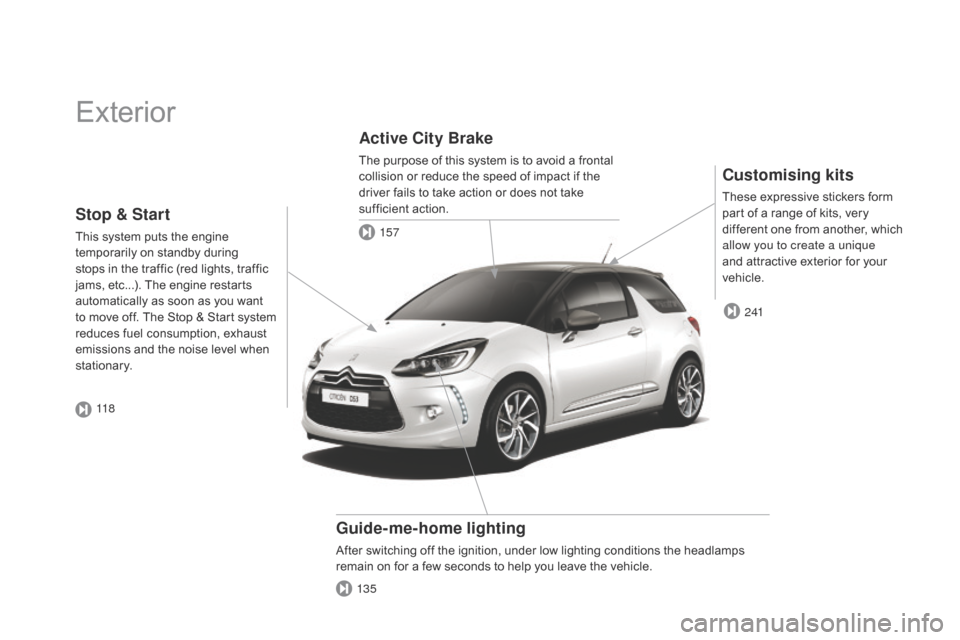
DS3_en_Chap00b_vue-ensemble_ed01-2014
Exterior
customising kits
These expressive stickers form part of a range of kits, very
d
ifferent one from another, which
a
llow you to create a unique
and
attractive exterior for your
v
ehicle.
Guide-me-home lighting
After switching off the ignition, under low lighting conditions the headlamps remain on for a few seconds to help you leave the vehicle.
Active city Brake
The purpose of this system is to avoid a frontal collision or reduce the speed of impact if the
d
river fails to take action or does not take
s
ufficient action.
2 41
13 5 157
Stop & Start
This system puts the engine t
emporarily on standby during
s
tops in the traffic (red lights, traffic
j
ams, etc...). The engine restarts
a
utomatically as soon as you want
t
o move off. The Stop & Start system
r
educes fuel consumption, exhaust
e
missions and the noise level when
s
tationary. 118
Page 16 of 376
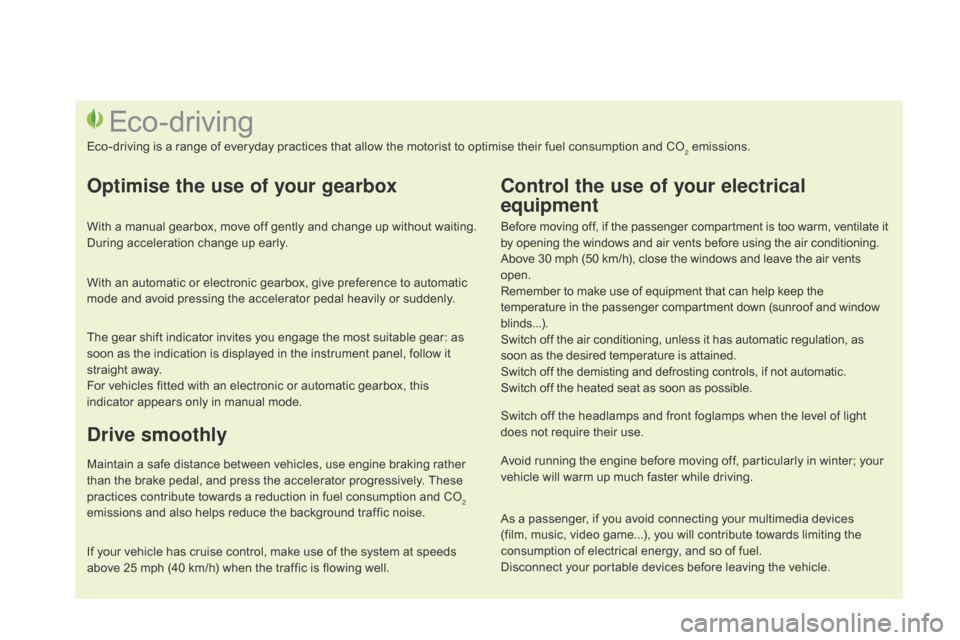
DS3_en_Chap00c_eco-conduite_ed01-2014
Before moving off, if the passenger compartment is too warm, ventilate it by opening the windows and air vents before using the air conditioning.
Above
30 mph (50 km/h), close the windows and leave the air vents
ope
n.
Remember
to make use of equipment that can help keep the
t
emperature in the passenger compartment down (sunroof and window
b
linds...).
Switch
off the air conditioning, unless it has automatic regulation, as
s
oon as the desired temperature is attained.
Switch
off the demisting and defrosting controls, if not automatic.
Switch
off the heated seat as soon as possible.
Switch
off the headlamps and front foglamps when the level of light
d
oes not require their use.
Avoid
running the engine before moving off, particularly in winter; your
v
ehicle will warm up much faster while driving.
Eco-driving
Eco-driving is a range of everyday practices that allow the motorist to optimise their fuel consumption and CO2 emissions.
Optimise the use of your gearbox
With a manual gearbox, move off gently and change up without waiting. During acceleration change up early.
With
an automatic or electronic gearbox, give preference to automatic
m
ode and avoid pressing the accelerator pedal heavily or suddenly.
The
gear shift indicator invites you engage the most suitable gear: as
s
oon as the indication is displayed in the instrument panel, follow it
s
traight away.
For
vehicles fitted with an electronic or automatic gearbox, this
i
ndicator appears only in manual mode.
drive smoothly
Maintain a safe distance between vehicles, use engine braking rather than the brake pedal, and press the accelerator progressively. These
p
ractices contribute towards a reduction in fuel consumption and CO
2
emissions
and
also
helps
reduce
the
background
traffic
noise.
control the use of your electrical
equipment
If your vehicle has cruise control, make use of the system at speeds a bove 25 mph (40 km/h) when the traffic is flowing well.As
a passenger, if you avoid connecting your multimedia devices
(
film, music, video game...), you will contribute towards limiting the c
onsumption of electrical energy, and so of fuel.
Disconnect your portable devices before leaving the vehicle.
Page 25 of 376
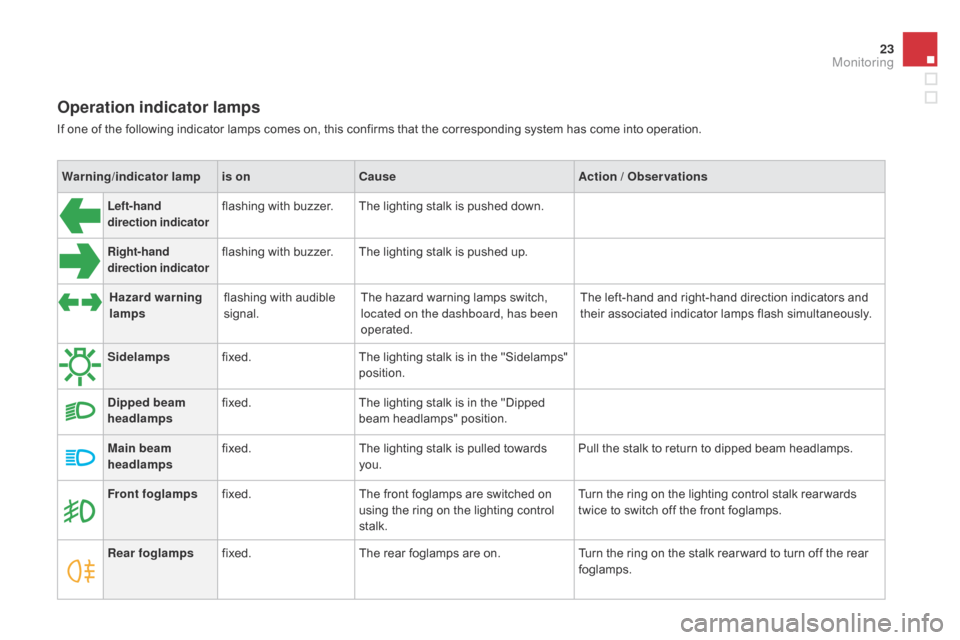
23
DS3_en_Chap01_controle-de-marche_ed01-2014
Operation indicator lamps
If one of the following indicator lamps comes on, this confirms that the corresponding system has come into operation.
W arning /indicator lampis on
cau
seAction / Observations
Left-hand
direction indicatorflashing with buzzer.The lighting stalk is pushed down.
Right-hand
direction indicatorflashing with buzzer.The lighting stalk is pushed up.
Sidelamps fixed. The
lighting stalk is in the "Sidelamps"
p
osition.
di
pped beam
headlamps fixed.
The
lighting stalk is in the "Dipped
b
eam headlamps" position.
Main beam
headlamps fixed.
The
lighting stalk is pulled towards
yo
u. Pull
the stalk to return to dipped beam headlamps.
Front foglamps fixed. The
front foglamps are switched on
u
sing the ring on the lighting control
st
alk. Turn
the ring on the lighting control stalk rear wards
t
wice to switch off the front foglamps.
Rear foglamps fixed. The
rear foglamps are on.Turn
the ring on the stalk rear ward to turn off the rear
fo
glamps.
Hazard warning
lamps
flashing
with audible
s
ignal. The
hazard warning lamps switch,
l
ocated on the dashboard, has been
operated. The
left-hand and right-hand direction indicators and
t
heir associated indicator lamps flash simultaneously.
Monitoring
Page 84 of 376
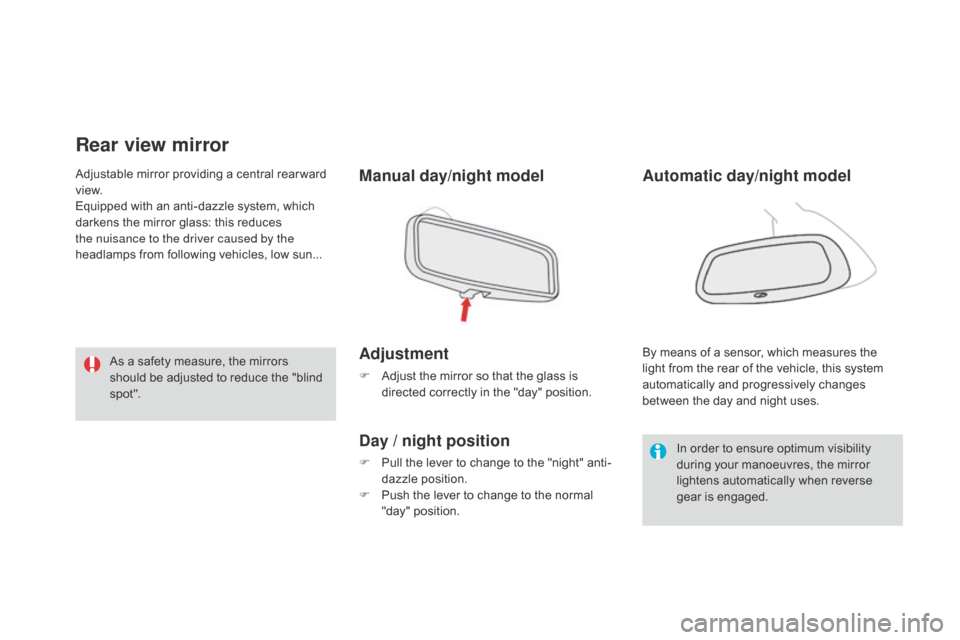
DS3_en_Chap04_confort_ed01-2014
Rear view mirror
Manual day/night model
Adjustment
F Adjust the mirror so that the glass is d
irected correctly in the "day" position.
day / night position
F Pull the lever to change to the "night" anti-
dazzle position.
F
P
ush the lever to change to the normal
"
day" position. By
means of a sensor, which measures the
l
ight from the rear of the vehicle, this system
a
utomatically and progressively changes
b
etween the day and night uses.
Automatic day/night model
In order to ensure optimum visibility d
uring your manoeuvres, the mirror
l
ightens automatically when reverse
g
ear
i
s
enga
ged.
As
a
safety
measure,
the
mirrors
s
hould
be
adjusted
to
reduce
the
"blind
s
p ot ".
Adjustable
mirror
providing
a
central
rear ward
v
iew.
Equipped
with
an
anti-dazzle
system,
which
d
arkens
the
mirror
glass:
this
reduces
t
he nuisance to the driver caused by the
headlamps
from
following
vehicles,
low
sun...
Page 132 of 376
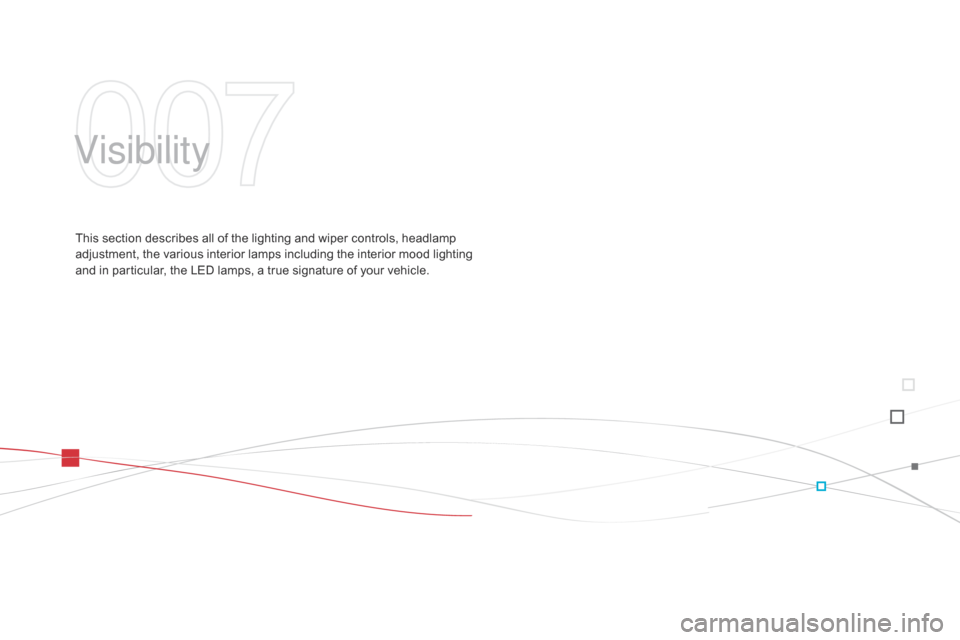
DS3_en_Chap07_visibilite_ed01-2014
Visibility
This section describes all of the lighting and wiper controls, headlamp adjustment, the various interior lamps including the interior mood lighting
a
nd in particular, the LED lamps, a true signature of your vehicle.
Page 134 of 376
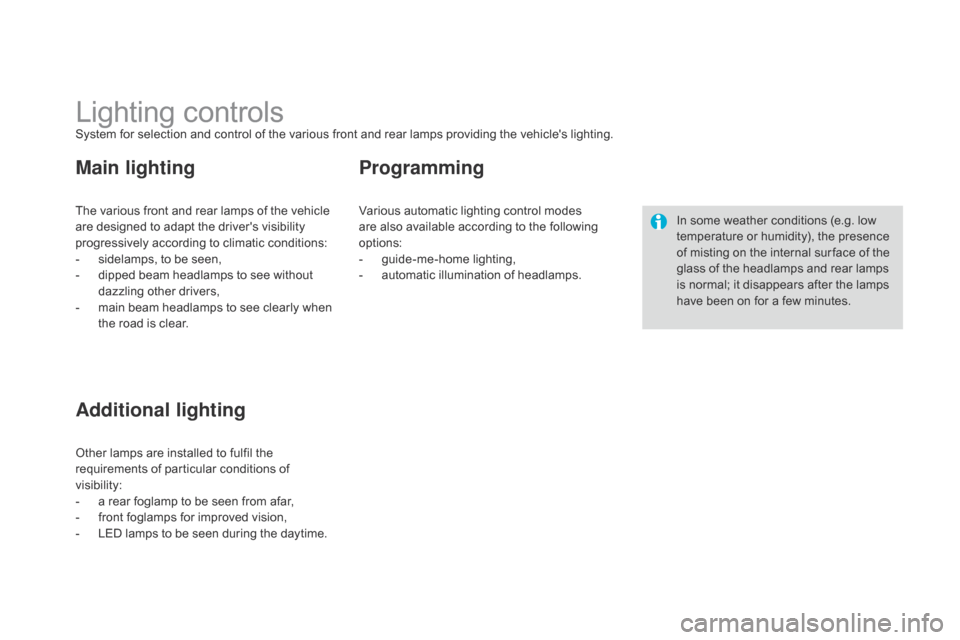
DS3_en_Chap07_visibilite_ed01-2014
Lighting controlsSystem for selection and control of the various front and rear lamps providing the vehicle's lighting.
T he various front and rear lamps of the vehicle
a
re designed to adapt the driver's visibility
p
rogressively according to climatic conditions:
-
s
idelamps, to be seen,
-
d
ipped beam headlamps to see without
d
azzling
o
ther
d
rivers,
-
m
ain beam headlamps to see clearly when
t
he road is clear.
Main lighting
Other lamps are installed to fulfil the requirements of particular conditions of
v
isibility:
-
a
rear foglamp to be seen from afar,
-
f
ront foglamps for improved vision,
-
L
ED lamps to be seen during the daytime.
Additional lighting
Various automatic lighting control modes are also available according to the following
op
tions:
-
g
uide-me-home lighting,
-
a
utomatic illumination of headlamps.
Programming
In some weather conditions (e.g. low temperature or humidity), the presence
o
f misting on the internal sur face of the
g
lass of the headlamps and rear lamps
i
s normal; it disappears after the lamps
h
ave been on for a few minutes.
Page 135 of 376
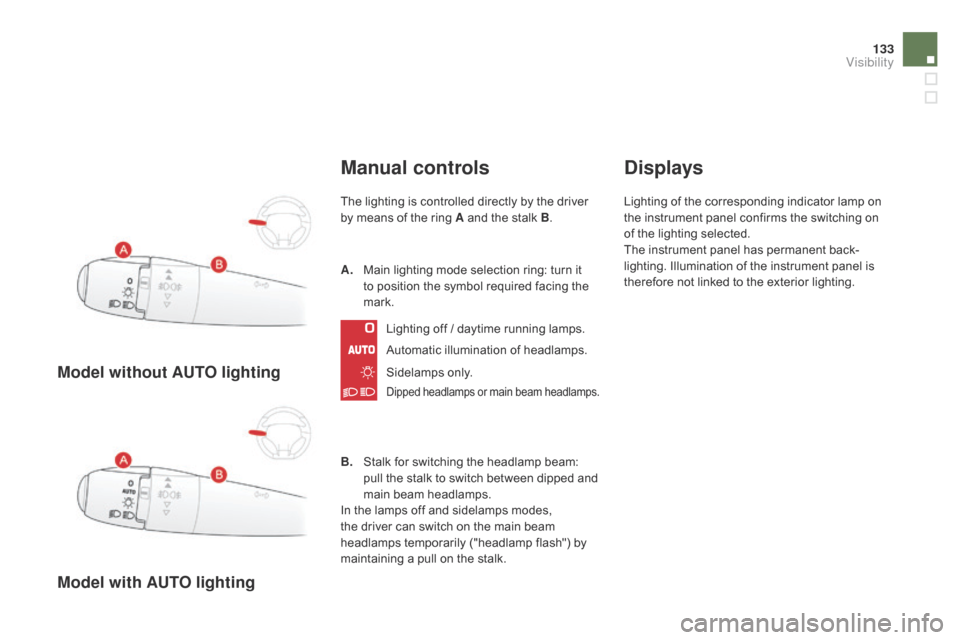
133
DS3_en_Chap07_visibilite_ed01-2014
Model without AUTO lighting
Model with AUTO lighting
Manual controls
The lighting is controlled directly by the driver by means of the ring A and the stalk B.
Automatic
illumination of headlamps.
B.
S
talk for switching the headlamp beam:
p
ull the stalk to switch between dipped and
m
ain beam headlamps.
In
the lamps off and sidelamps modes,
t
he driver can switch on the main beam
h
eadlamps temporarily ("headlamp flash") by
m
aintaining a pull on the stalk.
A.
M
ain lighting mode selection ring: turn it
t
o position the symbol required facing the
ma
rk.Lighting
off / daytime running lamps.
Sidelamps
o
nly.
Dipped headlamps or main beam headlamps.
displays
Lighting of the corresponding indicator lamp on the instrument panel confirms the switching on
o
f the lighting selected.
The
instrument panel has permanent back-
lighting.
Illumination of the instrument panel is
t
herefore not linked to the exterior lighting.
Visibility
Page 137 of 376
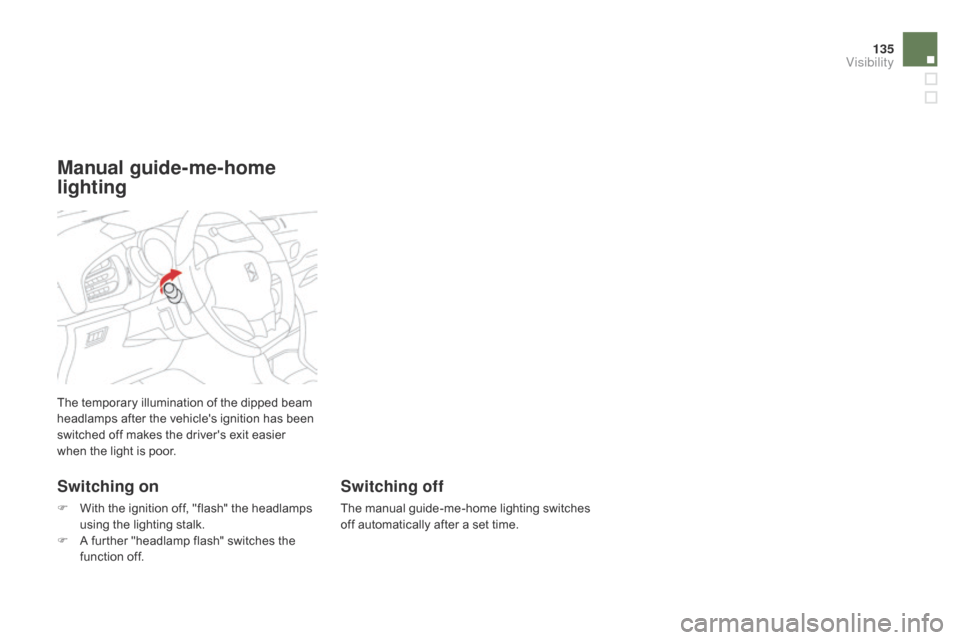
135
DS3_en_Chap07_visibilite_ed01-2014
The temporary illumination of the dipped beam headlamps after the vehicle's ignition has been
s
witched off makes the driver's exit easier
w
hen the light is poor.
Switching on
F With the ignition off, "flash" the headlamps u
sing the lighting stalk.
F
A
further "headlamp flash" switches the
f
unction off.
Switching off
The manual guide-me-home lighting switches off automatically after a set time.
Manual guide-me-home
lighting
Visibility
Page 138 of 376
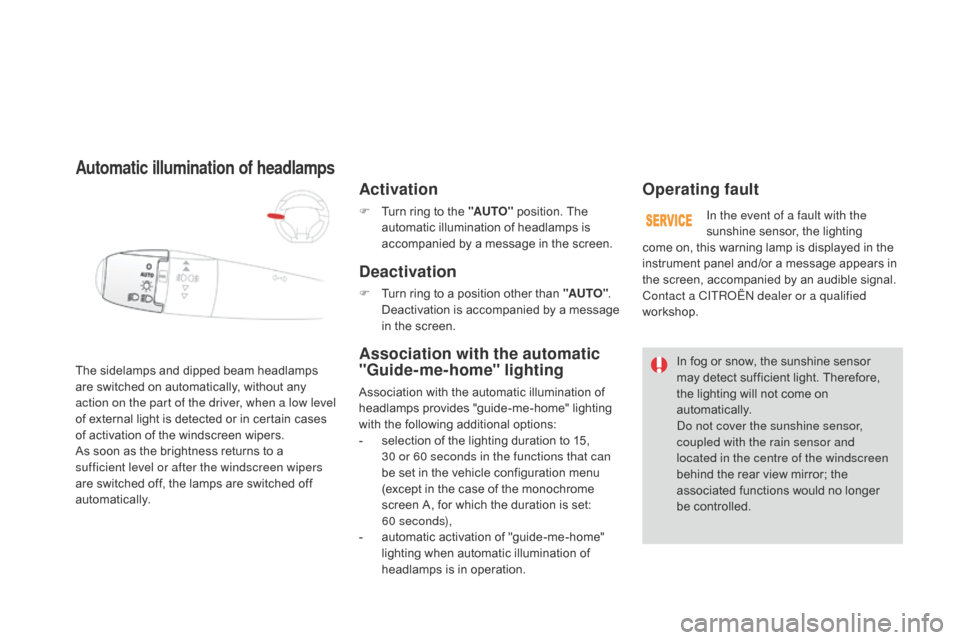
DS3_en_Chap07_visibilite_ed01-2014
The sidelamps and dipped beam headlamps are switched on automatically, without any
a
ction on the part of the driver, when a low level
of
external light is detected or in certain cases
o
f activation of the windscreen wipers.
As
soon as the brightness returns to a
s
ufficient level or after the windscreen wipers
are
switched off, the lamps are switched off
au
tomatically.
Automatic illumination of headlamps
Activation
F Turn ring to the "AUTO" position. The a
utomatic illumination of headlamps is
a
ccompanied by a message in the screen.
deactivation
F Turn ring to a position other than "AUTO". D
eactivation is accompanied by a message
i
n the screen.
Association with the automatic
"Guide-me-home" lighting
Association with the automatic illumination of headlamps provides "guide-me-home" lighting
w
ith the following additional options:
-
s
election of the lighting duration to 15,
30 or 60 seconds in the functions that can
be
set in the vehicle configuration menu
(
except in the case of the monochrome
s
creen A, for which the duration is set:
60 seconds),
-
a
utomatic activation of "guide-me-home"
l
ighting when automatic illumination of
h
eadlamps is in operation.
Operating fault
In the event of a fault with the
sunshine sensor, the lighting
c
ome
on,
this warning lamp is displayed in the
i
nstrument
panel and/or a message appears in
t
he
screen,
accompanied by an audible signal.
Contact a CITR
oË
N dealer or a qualified
workshop.
In
fog or snow, the sunshine sensor
m
ay
detect sufficient light. Therefore,
t
he
lighting will not come on
au
tomatically.
Do not cover the sunshine sensor,
coupled with the rain sensor and
located in the centre of the windscreen
behind
the rear view mirror; the
a
ssociated functions would no longer
be c
ontrolled.
Page 139 of 376
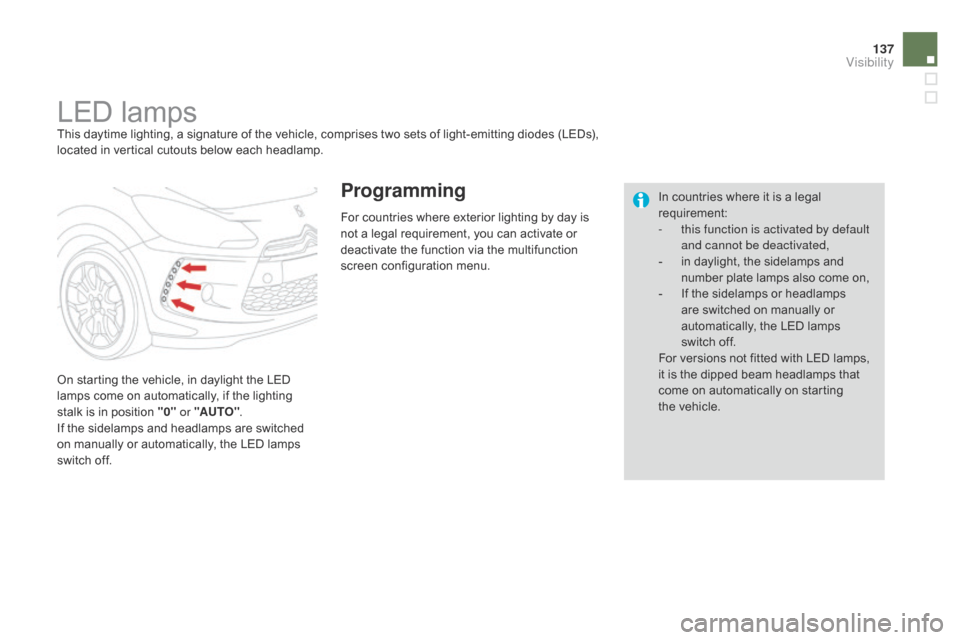
137
DS3_en_Chap07_visibilite_ed01-2014
LED lampsThis daytime lighting, a signature of the vehicle, comprises two sets of light-emitting diodes (LEDs), located in vertical cutouts below each headlamp.
On
starting the vehicle, in daylight the LED
l
amps come on automatically, if the lighting
s
talk is in position "0" or "AUTO" .
If
the sidelamps and headlamps are switched
o
n manually or automatically, the LED lamps
s
witch off. For
countries where exterior lighting by day is
n
ot a legal requirement, you can activate or
d
eactivate the function via the multifunction
s
creen configuration menu.
ProgrammingIn countries where it is a legal requirement:
-
t
his function is activated by default
and cannot be deactivated,
-
i
n daylight, the sidelamps and
n
umber plate lamps also come on,
-
I
f the sidelamps or headlamps
a
re switched on manually or
a
utomatically, the LED lamps
s
witch off.
For
versions not fitted with LED lamps,
i
t is the dipped beam headlamps that
c
ome on automatically on starting
t
he vehicle.
Visibility